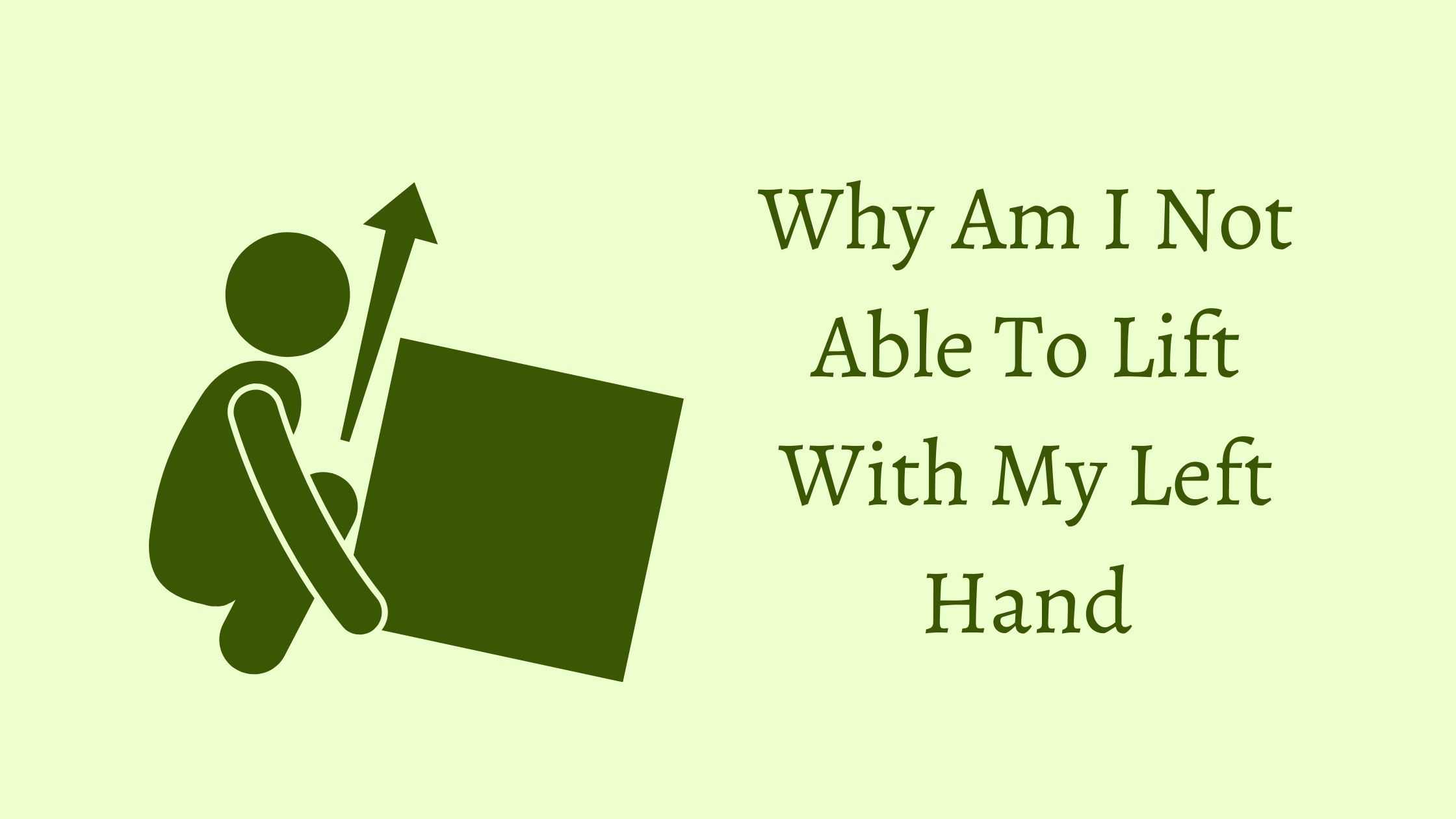
There could be several reasons why you are not able to lift with your left hand. The first and most common reason is a physical injury or condition. For example, a strain or sprain in the muscles or tendons of the left arm can make it difficult to lift objects. Similarly, nerve damage in the arm can affect the ability to lift, especially if it affects the muscles that control the hand and fingers.
Why am I not able to lift with my left hand?
There could be several reasons why you are not able to lift with your left hand. It could be due to a physical injury or condition, such as a strain or sprain, nerve damage, or a degenerative disease like osteoarthritis. It could also be due to a lack of strength or muscle imbalances caused by favoring one hand over the other. If you have any pain or discomfort, it is best to see a doctor or physical therapist for an evaluation and proper diagnosis.
Another common cause of difficulty lifting with the left hand is degenerative diseases such as osteoarthritis or rheumatoid arthritis. These conditions can affect the joints in the arm, making it difficult to lift objects. This is particularly true if the arthritis is severe and has led to joint damage.
A lack of strength in the left arm can also make it difficult to lift objects. This can be caused by disuse or muscle imbalances. For example, if you have a habit of favoring your right hand, over time, the muscles in your left arm may become weaker. This can make it difficult to lift objects with your left hand.
In some cases, psychological factors can also play a role in difficulty lifting with the left hand. For example, pain, fear, or trauma can cause a person to avoid using a certain limb. This can lead to decreased muscle strength, flexibility, and coordination in that limb, making it difficult to lift objects.
It’s also important to consider any underlying medical conditions such as a stroke, spinal cord injuries, or multiple sclerosis that may affect the ability to move and control the left hand.
If you are experiencing difficulty lifting with your left hand, it is important to see a doctor or physical therapist for an evaluation and proper diagnosis. They will be able to determine the underlying cause of your difficulty and develop an appropriate treatment plan. Treatment options may include physical therapy, medication, or in severe cases, surgery. However, it is important to note that recovery time and success can vary depending on the underlying cause and the severity of the condition.
5 Reasons For Why Am I Not Able To Lift With My Left Hand

- Physical injury: A strain, sprain, or tear in the muscles or tendons of the left arm can make it difficult to lift objects.
- Nerve damage: Damage to the nerves in the arm can affect the ability to lift, especially if it affects the muscles that control the hand and fingers.
- Degenerative diseases: Osteoarthritis, rheumatoid arthritis, and other degenerative diseases can affect the joints in the arm, making it difficult to lift objects.
- Lack of strength: If the left arm is weaker than the right arm, it may be more difficult to lift objects. This can be caused by disuse or muscle imbalances.
- Psychological factors: Sometimes, pain, fear or trauma can cause a person to avoid using a certain limb. This can lead to decreased muscle strength, flexibility and coordination in that limb, making it difficult to lift objects.
Shoulder Pain When Lifting The Arm
Shoulder pain when lifting the arm can be a frustrating and debilitating issue, often caused by various factors such as shoulder arthritis. This condition, characterized by inflammation in the shoulder joint, can lead to stiffness and pain, particularly when raising the arm.
Shoulder pain when lifting the arm can be caused by a variety of conditions. Some common causes include:
- Rotator cuff injury: The rotator cuff is a group of muscles and tendons that help to stabilize the shoulder joint. A tear or inflammation in these structures can cause pain when lifting the arm.
- Bursitis or tendinitis: Inflammation of the bursa (a small fluid-filled sac) or tendons in the shoulder can cause pain when lifting the arm.
- Impingement syndrome: This occurs when the tendons or bursa in the shoulder become compressed or pinched, causing pain when lifting the arm.
- Arthritis: Osteoarthritis or rheumatoid arthritis can cause pain, stiffness and inflammation in the shoulder joint, making it difficult to lift the arm.
- Frozen shoulder: A condition where the shoulder becomes stiff, making it difficult to move the arm. It often causes pain when lifting the arm.
It’s important to consult with a doctor or physical therapist for a proper diagnosis if you have shoulder pain when lifting your arm. Treatment options may include physical therapy, medication, or in severe cases, surgery.
Treatment
Treatment for difficulty lifting with the left hand will depend on the underlying cause. Here are a few common treatment options:
- Physical therapy: A physical therapist can help to strengthen the muscles in the left arm, improve flexibility and range of motion, and correct muscle imbalances. They can also teach you exercises to improve your ability to lift objects with your left hand.
- Medication: Non-steroidal anti-inflammatory drugs (NSAIDs) such as ibuprofen or naproxen can help to reduce pain and inflammation. In cases of arthritis, your doctor may prescribe disease-modifying anti-rheumatic drugs (DMARDs) or biologic agents.
- Surgery: In some cases, surgery may be necessary to repair a rotator cuff tear or other injury. Surgery may also be needed to repair damage caused by degenerative diseases such as osteoarthritis.
- Occupational therapy: An occupational therapist can help you learn new ways to do your daily activities, such as dressing, grooming and eating, that you might find difficult with the use of your left hand.
- Brace or splint: A brace or splint can help to immobilize the affected joint, reducing pain and allowing the injury to heal.
It is important to work closely with your doctor or physical therapist to determine the best treatment plan for your specific condition. Remember that recovery time and success can vary depending on the underlying cause and the severity of the condition.
You may also check out the latest post about Health, Fitness, Skin Care and Weight Loss on our Facebook Page and Twitter Page.
Final Thought
Difficulty lifting with the left hand can be caused by a variety of conditions, including physical injury, degenerative diseases, lack of strength, psychological factors, and underlying medical conditions. It is important to see a doctor or physical therapist for an evaluation and proper diagnosis to determine the underlying cause of the difficulty. Treatment options, such as physical therapy, medication, surgery, occupational therapy, or bracing, can help to alleviate symptoms and improve the ability to lift objects with the left hand. Remember that recovery time and success can vary depending on the underlying cause and the severity of the condition. It’s important to work closely with your healthcare provider to develop an appropriate treatment plan and make sure that you are following it as prescribed.
Thanks For Reading!